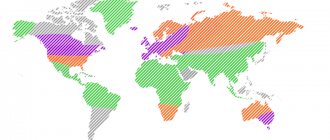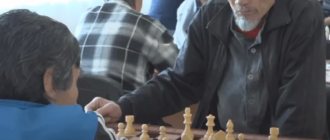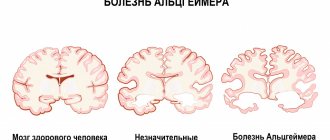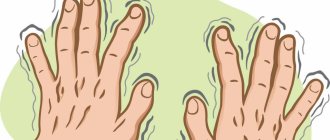Alzheimer's disease is a severe neurocognitive disorder, expressed in the loss of mental abilities against the background of irreversible changes in the tissues of the cerebral cortex and subcortical structures.
According to statistics, from 60 to 80% of all cases of dementia are the result of the progression of Alzheimer's disease. This pathology affects about 40 million people worldwide, and by 2050 this number is expected to double. The disease affects older people, the largest percentage of patients are in the category of 85 years and older, but it also occurs among people in younger age groups, with its active registration in patients over 65 years of age.
Causes and mechanisms of disease development
Risk factors for developing the disease:
- age over 65 years;
- family history of Alzheimer's disease;
- the presence of mutations in certain genes (at least five chromosomes contain areas that can influence the development of pathology);
- vascular diseases;
- metabolic pathology;
- low levels of education and cognitive activity throughout life;
- traumatic brain injuries, operations.
The main hypothesis for the development of the disease is based on assumptions about the incorrect synthesis of special proteins, which are precursors of the so-called amyloid. This substance accumulates in the tissues of the central nervous system, disrupting its functioning. Neurons die, nerve connections (synapses) stop working, and neurotransmitters - substances that trigger all the most important processes in the nervous system - are not produced. All this causes atrophy (fading of functions, death) of the affected areas of the brain.
The mechanisms of pathology progression are being actively studied, but so far scientists have not been able to fully uncover them. Therefore, Alzheimer's disease today remains steadily progressing (although some slowing down of this process is possible) and incurable.
Kinds
The forms of the disease are divided according to age:
- with early (before 65 years) onset
- with late (after 65 years) onset
- atypical Alzheimer's disease (mixed type with vascular or other problems)
They differ not only in the age of onset of the disease. Often the timing of the onset of the first symptoms of Alzheimer's disease cannot be accurately determined, they are so invisible. It is important that the forms of Alzheimer's disease have significant differences in the clinical picture and features of the development of the disease, this allows for more accurate diagnosis.
Manifestations of Alzheimer's disease
The clinical picture of the disease corresponds to progressive dementia. The first signal is loss of short-term memory. Sick people forget the names or purposes of familiar objects and put them in strange places. They ask the same questions several times in a row and do not remember the answers. As the disease progresses, patients begin to forget the names and faces of relatives and friends, their own name, and do not recognize themselves in the mirror.
Impairments affect the ability to think and reason. First, the person loses the thread of the narrative and voices the same thought several times. He cannot reason, solve complex problems with abstract objects, and then simple everyday issues. He becomes short-sighted, absent-minded, and cannot calculate his actions and their results several steps ahead.
Difficulties with speech appear. It increasingly contains slips of the tongue, mistakes and substitution of concepts. As the illness progresses, it becomes more and more difficult for a person to speak, he confuses words (in meaning and places). When writing, he makes a lot of mistakes (even if he was previously very literate) and typos, then this function is completely lost.
The ability to navigate in time and space is impaired. The person does not know the current date and year, does not remember where he is and how to return home, does not understand whether he is in his home or in a medical facility, or how long ago he arrived at his location.
Characterized by disturbances in behavior and emotional reactions. Patients are whiny, irritable, aggressive, and do not accept any innovations. Vagrancy may occur (which, in combination with memory impairment and inability to navigate, is extremely dangerous), agitation, and delusions of persecution. Characterized by depression and apathy.
Subsequent violations
As the disease progresses, the pathology spreads to other parts of the brain. The patient confuses events and is not oriented in space and time. He develops senile dementia. An elderly person’s memory does not retain vocabulary, so speech becomes incomprehensible. He tries to replace the missing words with others, and the meaning of the statements is completely lost.
Life skills are lost: an elderly person cannot take care of himself, wash, dress, or eat. He doesn't remember how to do it and can no longer learn it. Personality deformation occurs:
- isolation appears;
- aggression;
- irritability;
- anxiety;
- signs of depression.
At the last stage of Alzheimer's, pensioners become bedridden patients. They have impaired motor function, control of urination and defecation. Patients have difficulty swallowing food.
Patients with Alzheimer's live an average of 8 years. During this time, a pensioner with Alzheimer's loses the knowledge, skills and abilities that have been accumulated throughout life irrevocably.
Self-diagnosis of the disease
Some older people experience age-related character changes that are not for the better, and this has nothing to do with the onset of Alzheimer's disease. Many older people experience problems with memory and attention or a fear of new things. However, if relatives are worried about their elderly relative, noticing that these changes are significant and progressing, then consultation with a specialist is necessary. Even before seeing a geriatrician or neurologist, you can do some tests on your own to determine Alzheimer's disease. It is best to do this in the form of a game or “random” requests, so as not to cause a negative reaction from the person and not upset him with your suspicions.
The first task may be to calculate some amount, for example, to estimate approximately what the cost of purchases in a store or pharmacy will be. Other options are filling out a receipt or helping your grandchildren with school math.
A person with Alzheimer's disease has difficulty doing things according to instructions, so another test might be something like cooking a recipe.
It is worth assessing whether a person often loses his things, puts them in unusual or incorrect places (a toothbrush in the refrigerator). How severe is forgetfulness in describing events or habitual actions (turn off the stove or kettle, close the door, call when requested). It is important to monitor how logical a person’s narrative is, whether he often repeats the same thoughts, and confuses words. An alarming signal may be a fading interest in your favorite things, hobbies, and TV shows.
Patient care
Relatives have the hardest time. It is important to realize that a loved one is becoming more and more helpless and to understand that the patient’s behavior is provoked by an illness. The key to success is patience with the patient. It is necessary to create safety, proper nutrition, prevent bedsores and maintain immunity, and try to provide complete protection from stressful situations. Doctors recommend making an appointment with a psychologist, since in the life of a person caring for a patient, as a rule, psycho-emotional disorders, depression, and social and economic problems arise. As the disease progresses, the patient will experience various complications, such as diseases of the teeth and oral cavity, impaired ability to feed independently (later problems with swallowing food), respiratory diseases, eye and skin infections, etc. It is imperative to monitor the general somatic condition of the patient and at the first manifestation of problems, urgently look for solutions. Monitor the patient’s hygiene independently, including brushing teeth after each meal. Grind the food or turn it into a mushy state (if necessary, feeding is done through a tube). If necessary, restrain the patient to prevent harm to themselves or others.
Patient survey
One part of this Alzheimer's test consists of questions about forgetfulness, absent-mindedness, and other problems. The second consists of questions reflecting the real state of cognitive functions.
For example, the patient is asked to remember three unrelated words so that he can reproduce them at the end of the conversation. A relevant test involves drawing a clock face, in which you need to indicate the specified time. You need to name the current date, list the months of the year in reverse order and count from 20 to 1.
General information
Homocysteine is a product of the metabolism of cysteine and methionine. Its metabolism requires folic acid, B6 and B12. If they are deficient, the level of Homocysteine may increase. An excess of this substance leads to the development of serious health problems. Blood clots and damage to vessel walls may occur. Blood test for homocysteine
is often used to determine the likelihood of cardiovascular pathologies, but its value in this regard is questionable. Studies have found that replenishing folic acid and vitamin deficiencies does not reduce the risk of disease.
A sharp increase in indicators is often observed with homocysteinuria. This is a genetic disease in which there is a defect in the enzyme that prevents the breakdown of methionine. Amino acids accumulate in the body. A newborn with this disease is visually no different from healthy babies. Violations appear only after a few years. Children with this disease are thin and tall, and have thin fingers. They develop skeletal abnormalities, develop osteoporosis, and may develop early cardiovascular diseases.
Picture test
One of the most famous tests for detecting Alzheimer's is with pictures. Usually 4 pictures are offered, with three images showing the same object from different angles, and one showing a different one. A sick person usually cannot identify an extra picture and points to the wrong one, naming incorrect differences or not explaining anything at all. This happens because abstract and spatial thinking and the ability to analyze suffer. However, before taking the test, it is important to make sure that the person has sufficient vision.
Sample images:
Test "Four Mountains"
“The 4 Mountains Test”, or the game “Four Mountains” - was developed by American scientists. This is a short test, similar to the picture tasks. It assesses spatial reasoning, memory, analysis and correlation, and is highly sensitive for diagnosing Alzheimer's disease.
The patient is presented with a computer-generated landscape depicting four hills. A person sees a contour map (A), a diagram (B) and a volumetric frame ©, and carefully studies these data. After this, he is offered 4 pictures (D), of which 3 are the same mountains, only from different angles, and 1 is a different place. the patient needs to find the extra picture.
Simple test games
Simple tests for Alzheimer's are also used, which can be perceived by the patient as a game. Among an array of identical letters or numbers, you need to find a different one (for example, among the letters O - C, M - N, numbers 9 - 6). Another test with pictures can be proposed - the images contain obvious figures (trees, flowers, landscape) and non-obvious ones (faces, people. It is necessary to find “hidden” elements.
10 faces are “hidden” in the branches of the tree
The earth, rocks and branches create the outline of a child
Alzheimer's disease is a big challenge for the whole family. However, its progression can be slowed with proper treatment. And proper specialized care for patients in later stages will allow them to enjoy life and feel like full-fledged members of society for as long as possible.











